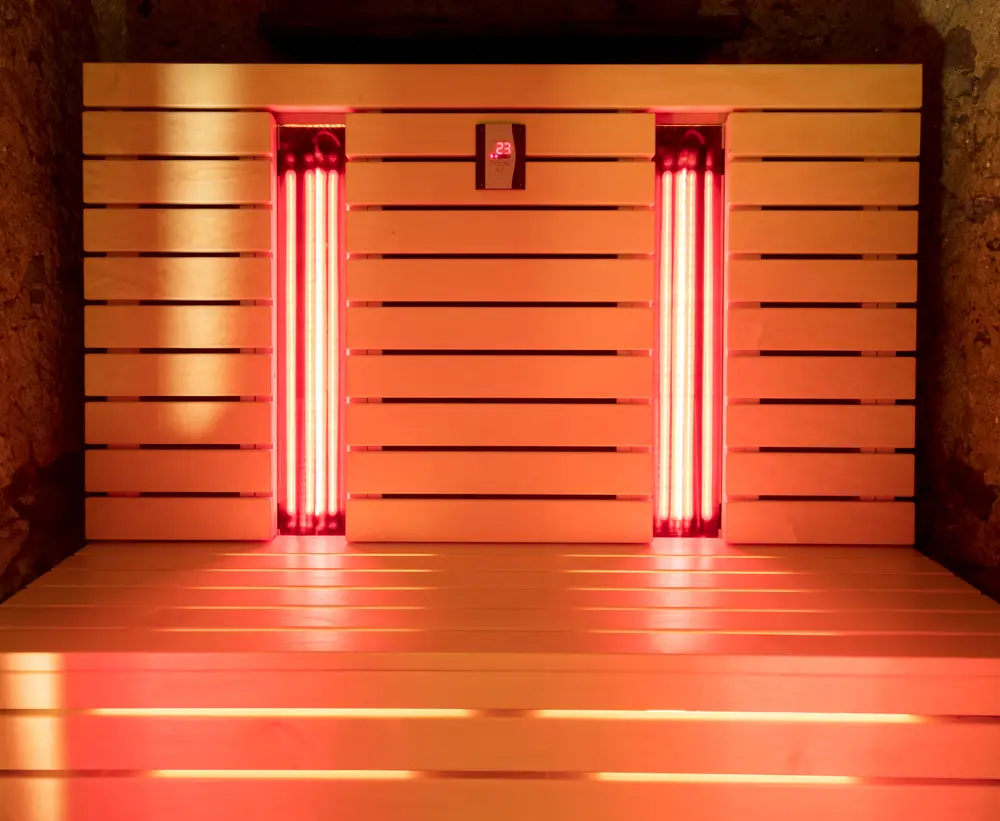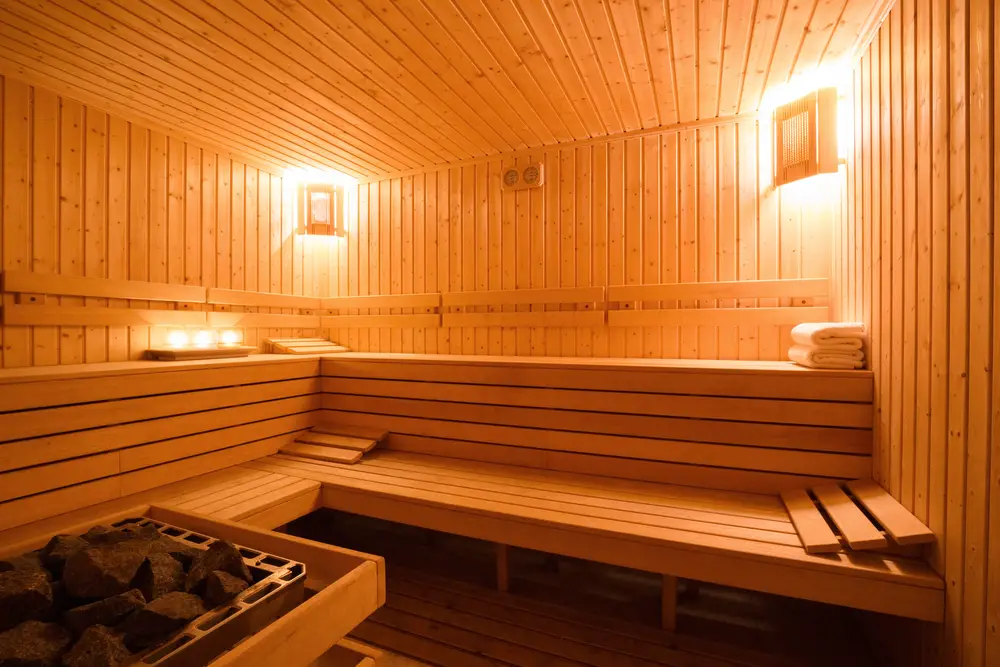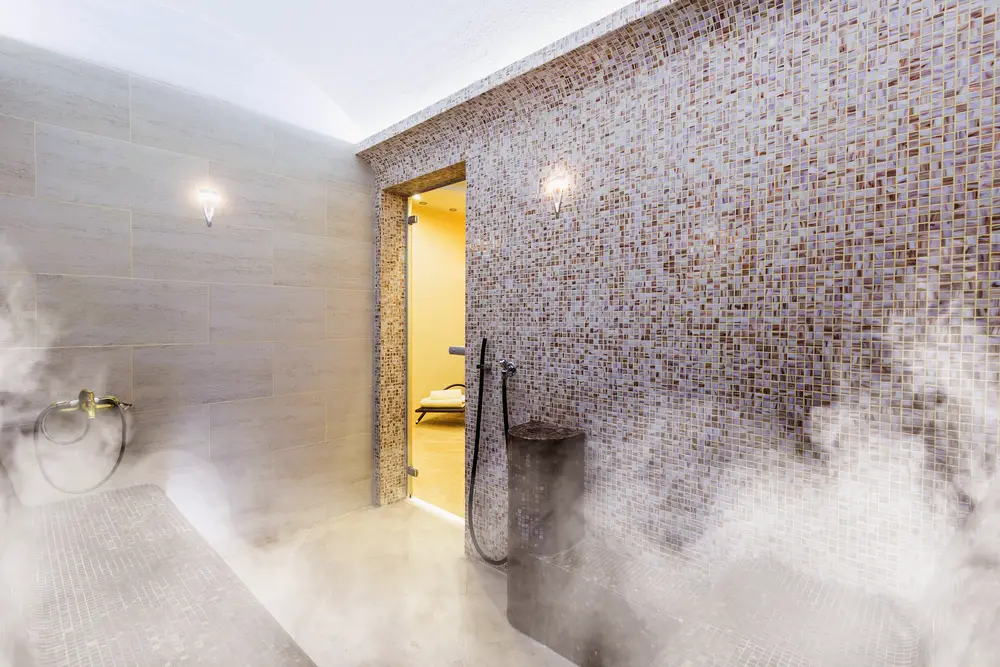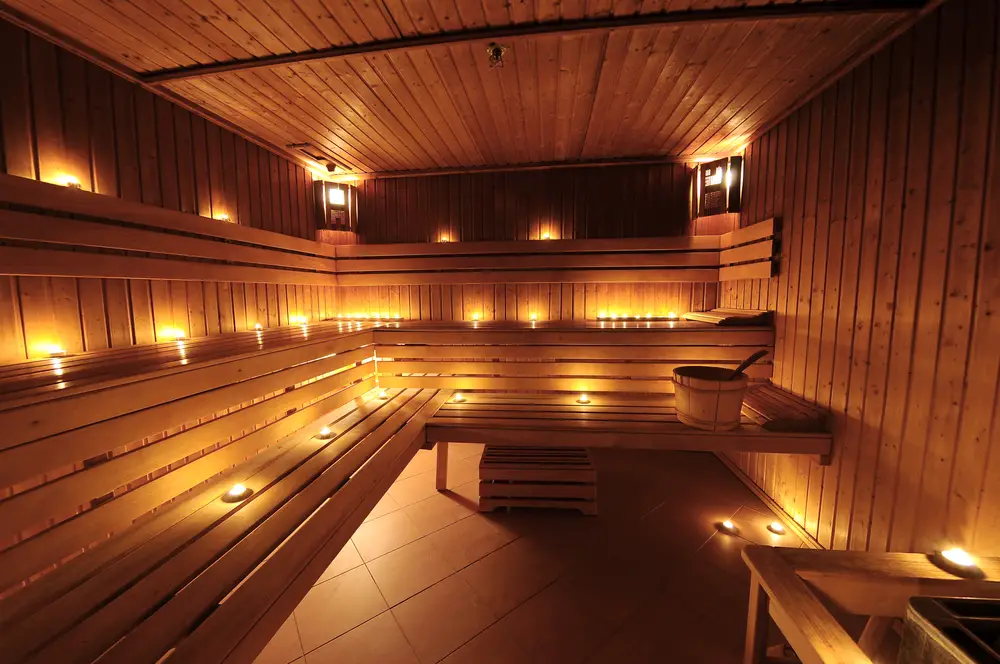The overall performance, durability, and comfort of your home sauna are significantly influenced by the materials used in its construction. Knowing the advantages and disadvantages of each home sauna building material is crucial.
Building materials for saunas are usually wood, tile, or stone. Wood offers insulation and a warm aesthetic. Tiles and stones offer durability and ease of cleaning. These materials enhance insulation, heat retention and hygiene in a sauna.
Are you curious about the advantages and disadvantages of various sauna construction materials? To learn more, keep reading.

What building materials are used to make a home sauna?
Typically, saunas are constructed from a variety of materials, each with its own distinct properties and advantages. Wood, rock, metal, and glass are among the most frequently employed materials in sauna construction.
Wood is the traditional building material for saunas because of its natural warmth and aesthetic appeal. Common sauna construction materials include cedar, hemlock, and redwood.
Each of these woods has its own distinct aroma, texture, and color, making it a popular option for sauna owners who wish to create a warm, inviting atmosphere.
Rock is another common material used in sauna construction, and it is frequently used to line the sauna’s walls and floor. Popular options include granite, marble, and slate because they are heat-resistant, long-lasting, and give the sauna a natural appearance and feel.
Stainless steel is frequently used for sauna fixtures and fittings. Stainless steel is durable, rust-resistant, and simple to clean, making it an ideal material for sauna components exposed to high temperatures and moisture.
Glass is frequently used for sauna doors and windows. This is typically accomplished with tempered glass, which can withstand high temperatures and is shatterproof. Clear or tinted glass is available, allowing light to enter the sauna and creating an airy, bright atmosphere.
What are the advantages and disadvantages of various sauna construction materials?
The construction material of a sauna has a significant impact on its quality and functionality. Here is a comprehensive look at the advantages and disadvantages of some of the most frequently employed materials:
The traditional material for saunas, wood imparts a warm, natural ambiance. It is absorbent and a good insulator, but it is flammable and requires fire-retardant treatments. To preserve its beauty, routine maintenance, such as sealing and staining, is necessary.
Stone, such as granite or marble, is resilient and long-lasting, making it ideal for outdoor saunas. However, it can be cold to the touch and difficult to manipulate.
Glass can give a sauna a contemporary and stylish appearance, but it may not offer the desired level of privacy. Glass is expensive to replace due to its ability to become hot and its fragility.
Acrylic is light, transparent, and simple to maintain, but it may not be as resistant to heat as other materials.
Stainless steel is resistant to rust and corrosion, but it may not hold heat well and can become hot to the touch.
Bamboo is an eco-friendly and renewable material with a natural appearance, but its durability may not match that of other materials. Recycled materials such as plastic or metal provide a sustainable alternative, but they may not retain heat as well as other materials.
Which woods are commonly used to build a sauna?

Wood is a popular material for sauna construction because of its natural and warm appearance. Commonly used for sauna buildings are numerous types of wood, each with distinct features and advantages.
Cedar: This wood is frequently used to construct saunas due to its resistance to decay and moisture, as well as its insulating properties, which assist retain sauna heat. Additionally, it has a lovely aroma.
Redwood is widely chosen for sauna construction due to its strength, durability, and resistance to rot and moisture. It is also an effective insulator and retains heat well.
Due to its low weight and silky texture, basswood is frequently utilized for sauna benches and interior elements. Also, basswood is an excellent insulator.
Aspen: This soft, light wood is widely used for sauna seats and interior parts since it is a good insulator and its light color helps illuminate the sauna’s interior.
Birch, a robust and resilient wood, is frequently used to construct saunas. It is an effective insulator with a light hue and smooth texture, giving the sauna a refined appearance.
Pine is a soft, lightweight wood commonly employed in sauna buildings. Pine is a popular choice for sauna benches and interior parts due to its excellent insulating capabilities, and it is also a budget-friendly material.
Related Read: Sauna Design and Layout Options
What are the defining characteristics of wood suitable for sauna buildings?
In order to ensure the durability and quality of a sauna, it is essential to select the proper type of wood when building one. To make the right decision, you must consider a number of important characteristics, including:
Durability: The wood must be able to withstand high humidity levels and heat without warping, rotting, or decaying over time.
Moisture Resistance: This quality helps to prevent deterioration in a high moisture environment, such as a sauna.
Insulation: Good insulation properties are necessary to retain heat and maintain a comfortable temperature inside the sauna.
Heat Resistance: The wood should be able to tolerate high temperatures without cracking or breaking.
Aroma: Many people associate saunas with the pleasant scent of wood, and choosing a wood with a natural fragrance can add to the overall experience.
Appearance: The appearance of the wood is also important and should complement the overall design of the sauna.
Affordability: Budget is also a crucial consideration, as the cost of wood can vary.
It is important to consider not only these characteristics, but also the climate and location of the sauna, as well as personal preferences, when making a selection. Woods such as cedar, redwood, basswood, aspen, birch, and pine are frequently used in sauna construction, and each offers distinct benefits and drawbacks.
How do you properly maintain and care for the wood used in a sauna?

The longevity and aesthetic appeal of the sauna depend on the proper maintenance and preservation of the wood used in the sauna. The following measures will help you properly maintain the wood:
Cleaning: To get rid of any filth and sweat accumulation, regularly wipe down the wood with a moist towel. As harsh chemicals can harm the wood, avoid using them.
Moisture control: Because saunas are notorious for their high humidity levels, it’s critical to manage moisture levels to avoid rot and warping. By turning on the heater for 15 to 30 minutes after each use and leaving the door open, you can keep the sauna dry in between uses.
Staining and sealing: Consider staining and sealing the wood to keep it protected and preserve its color. The wood can be given a beautiful finish with stains, which come in a range of shades while being shielded from moisture damage with sealers.
Repairs: To stop additional damage, the wood that has cracks, splits, or other damage should be fixed right away. Wood filler can be used to patch small fractures, and larger problems might call for more involved fixes.
Regular inspection: Check the wood frequently for any damage symptoms, such as cracks, splits, or warping. Any problems should be resolved right away to avoid future harm.
Avoid overuse: Saunas can be used regularly, but they shouldn’t be overused, primarily if they’re not properly maintained. Overuse can shorten the lifespan of wood by causing excessive wear and tear.
Related Read: Sauna Maintenance and Cleaning
Are there any sustainable and eco-friendly options for wood to use in a sauna?
Yes, environmentally responsible and sustainable wood options are available for sauna construction. When constructing or renovating a sauna, it is essential to consider the origin and effects of the wood. Here are many of the most eco-friendly options:
Here are some of the top environmentally friendly choices:
Bamboo: It can be utilized in saunas since it is quickly growing, sustainable, and renewable. Bamboo is a tough material for saunas because of its excellent resistance to moisture and insects.
Reclaimed wood can offer a sauna a distinctive and rustic appearance while minimizing waste and protecting natural resources.
Wood with the FSC (Forest Stewardship Council) accreditation has been sourced ethically from forests that have been properly managed. For saunas, FSC-certified wood is a fantastic alternative because it offers a sustainable and eco-friendly choice for individuals who appreciate environmental responsibility.
Cork: The bark of cork oak trees is used to produce cork, which is a sustainable resource. Cork is a fantastic material for saunas because of its superior moisture resistance and insulating capabilities. Cork is also antimicrobial, which contributes to the maintenance of a healthy indoor environment.
Other Eco-Friendly materials: A sauna can be built using other materials like linoleum, recycled plastic, and engineered wood goods.
What other factors should be considered when choosing materials for building a sauna?

What other factors should be considered when choosing materials for building a sauna?
In addition to moisture resistance, heat resistance, insulation, durability, aesthetics, maintenance, and budget, a number of other factors must be considered when selecting sauna-building materials. Here are a few additional factors to consider:
The materials used in a sauna must be noncombustible in order to prevent any potential fire hazards.
Proper ventilation is essential for a healthy sauna environment. Vents or windows should be incorporated into the sauna’s construction materials to ensure adequate ventilation.
Acoustics: The sauna’s materials should help to reduce noise levels and create a tranquil environment.
Some materials emit harmful chemicals or fumes when exposed to heat; therefore, it is essential to select materials that are safe for indoor use.
There are numerous credible resources from which to learn more about sauna building materials and their advantages. Here are some things to consider:
Saunas and your health, according to Healthline
These sources provide a wealth of information on sauna construction materials, including the advantages and disadvantages of each, enabling individuals to make informed decisions about the materials they use to construct their sauna.

